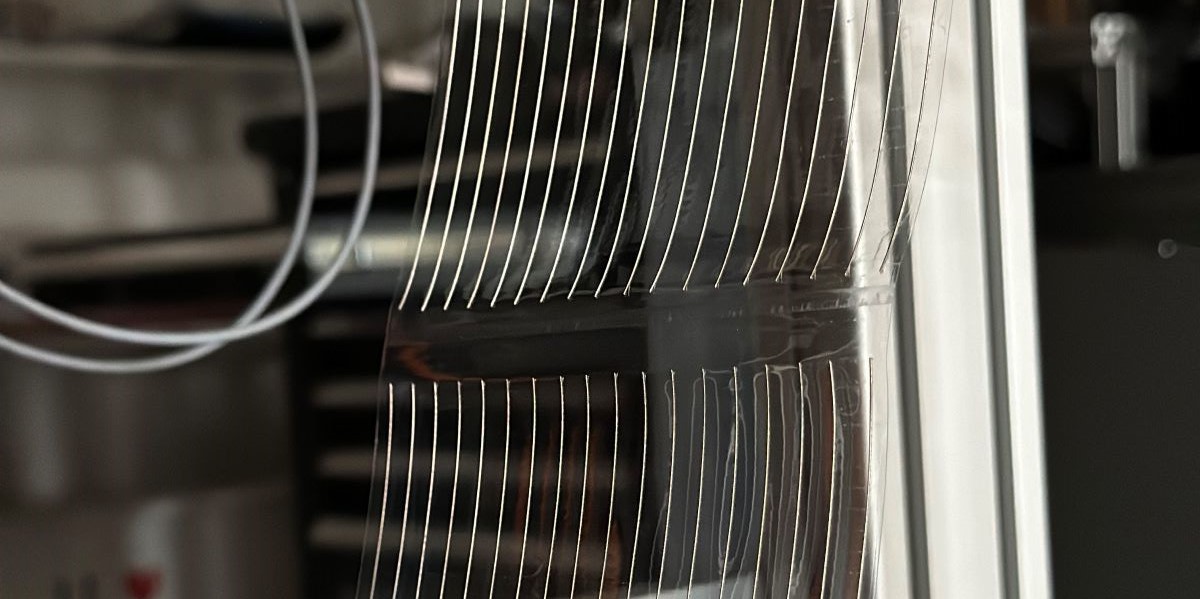Swedish stringer manufacturer Sticky Solar Power announced it is taking orders for its industrial-scale room-temperature cell interconnection system based on its tape solution, rather than soldering. Able to apply up to 20 busbars at a time, the throughput ranges from 2,500 to 3,500 single-track interconnections per hour.
The solar stringer supports lead-free interconnection and uses 60% less silver than conventional processes, according to co-founder and CEO, Jonas Buddgård. “It can integrate into any production line as it is made for batch or in-line production with a small factory footprint of just 6 m²,” Buddgård told pv magazine. “Equipped with an optional layup, the size increases to about 10 m², depending on output preferences.”
The initial target customers are European and U.S.-based manufacturers of back-contact (xBC), perovskite, heterojunction, and bifacial products.
The Sticky Solar Power stringer is based on a tape solution, that is, the interconnection wires are attached to an adhesive tape that is in turn applied precisely by the equipment to cell surfaces. The tape holds the wires and cells in place until the encapsulant lamination step. The tool eliminates single-cell soldering, effectively combining interconnection and lamination steps in one.
“With the stringing performed at room temperature, the maximum needed process temperature for the tape solution is as low as 150 C,” said Buddgård, noting that the equipment can be operated up to 24 hours a day, 365 days a year. It works with both ethylene vinyl acetate (EVA) copolymer and polyolefin elastomers (POE) materials.
“We made it competitively priced, comparable to other European manufacturers. The capital expenditure, perceived risk, and operating expenditures are competitive, that´s the whole idea with the tape solution,” added Buddgård.
While it is well-suited for lower temperature cell processing as an alternative to conventional soldering, the equipment also offers benefits to monocrystalline passivated emitter rear cell (PERC) and tunnel oxide passivated contact (TOPCon) product manufacturers, such as a reduced number of steps and less material consumption, according to the company.
Lower temperatures also mean a lower risk of solar cell cracking. It can also mitigate the warping or bowing of back-contact solar cells.
The cell technologies supported include heterojunction, perovskite, perovskite silicon tandem, PERC and TOPCon, bifacial, and xBC designs. It supports standard formats, such as M2, M6, M10 and M12. The tape has been used in back-contact mini-modules that passed IEC 61215 thermal cycling tests.
This content is protected by copyright and may not be reused. If you want to cooperate with us and would like to reuse some of our content, please contact: editors@pv-magazine.com.



By submitting this form you agree to pv magazine using your data for the purposes of publishing your comment.
Your personal data will only be disclosed or otherwise transmitted to third parties for the purposes of spam filtering or if this is necessary for technical maintenance of the website. Any other transfer to third parties will not take place unless this is justified on the basis of applicable data protection regulations or if pv magazine is legally obliged to do so.
You may revoke this consent at any time with effect for the future, in which case your personal data will be deleted immediately. Otherwise, your data will be deleted if pv magazine has processed your request or the purpose of data storage is fulfilled.
Further information on data privacy can be found in our Data Protection Policy.